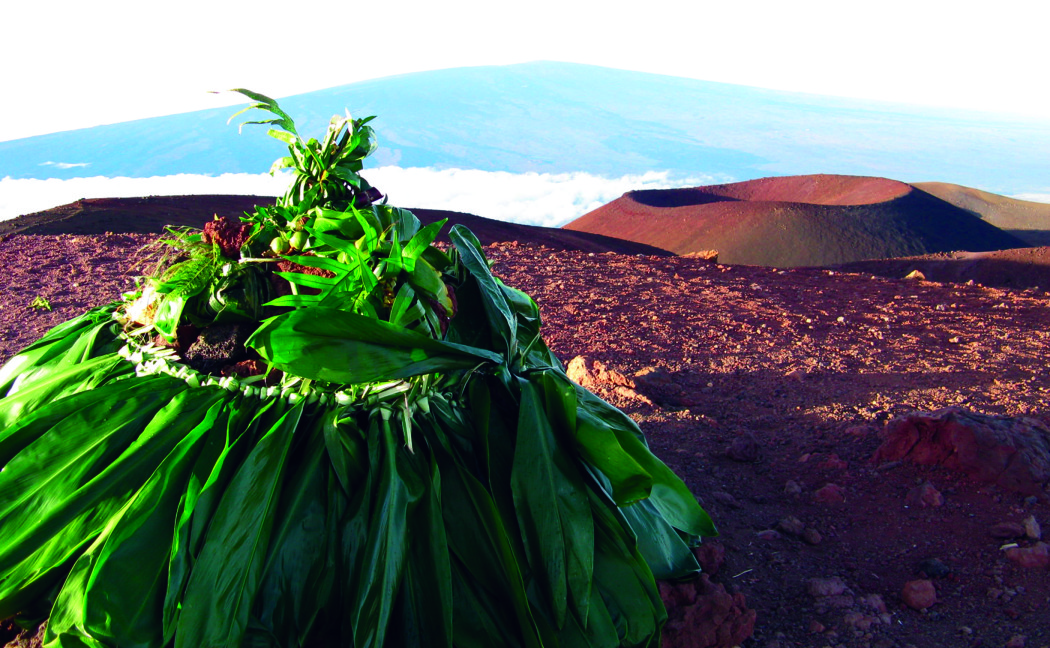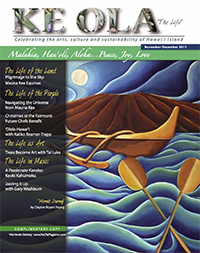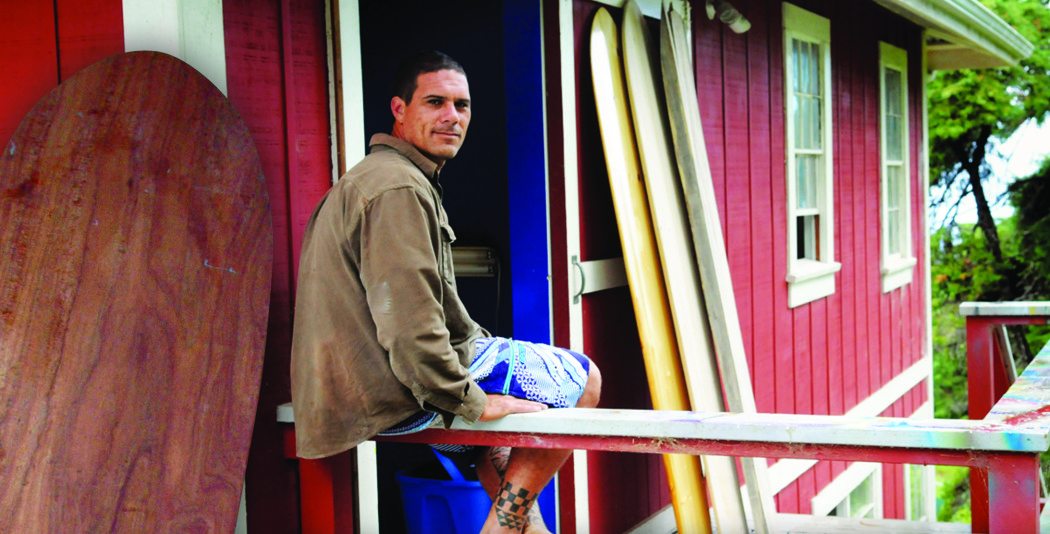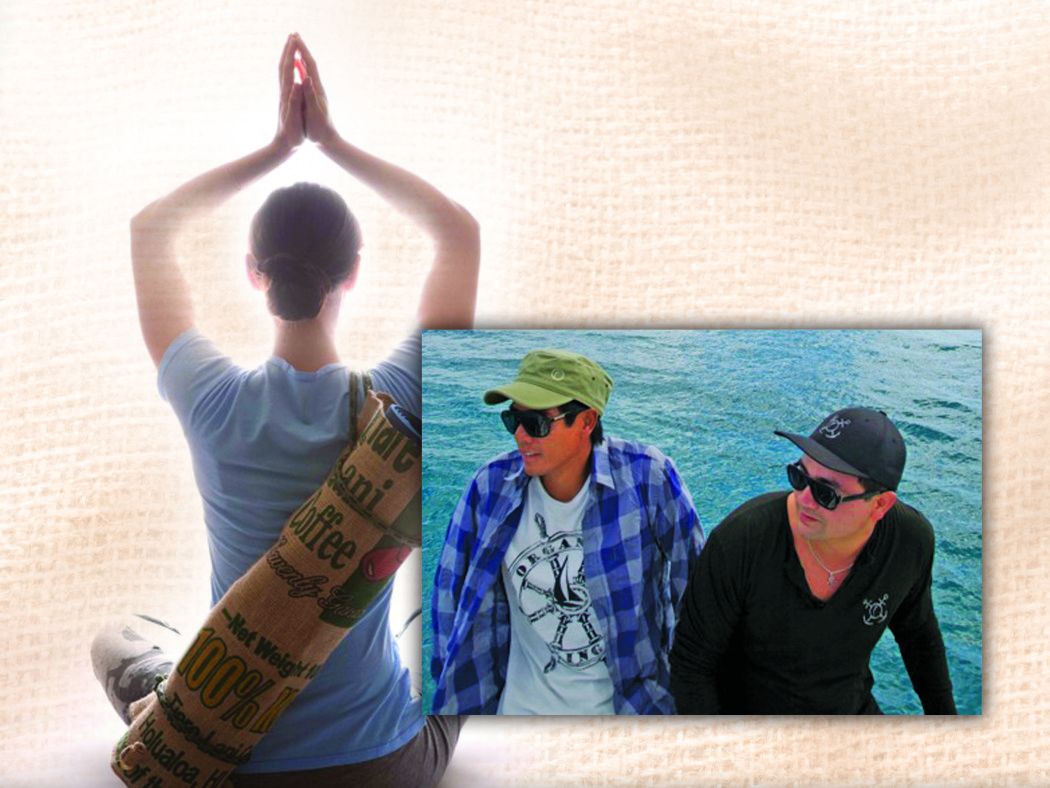
Pilgrimage to the Sky: Honoring Mauna Kea—Kuahiwi Kūha‘o i ka Mālie: Mountain Standing Alone in the Calm

By Marya Mann
The Summit Pu’u Wēkiu, Sunrise, Fall Equinox, 2011 – Shimmering in the first light of morning at the top of the world, the sun paints brilliant shades of red, orange, pink and gold on the mountain, igniting the tallest pu’u in all of Oceania, Wēkiu Peak, before cascading down the slopes of Mauna Kea and merging into the ‘āina.
This color phenomenon atop Mauna Kea is the manifestation of the deity Kū, spark of life, strength and prosperity, and accounts for the Hawaiian name of the ridge where the summit rises: Kūkahau’ula, “Kū of the rosy-tinted snow.”
The breathtaking scene illuminates the sacred Hawaiian ceremony about to take place. The mixed group, a congregation of Hawaiians and others invited to participate, gathers around a stone altar, built by Hawaiian practitioners to fulfill their mission to protect and honor the ‘āina
Mountain energy has inspired ancient Hawaiian culture—its cosmology, oli, hula and all the arts for millennia. To people like Kealoha Pisciotta, president of Mauna Kea Anaina Hou—a Native Hawaiian organization advocating greater protection of the land —the whole mountain is a sacred outdoor temple, the piko of the island, the umbilical cord where Sky Father (Wakea) and Earth Mother (Papahānaumoku) are connected. This altar on the summit is for making offerings to the ‘aumakua (spiritual ancestors).
This altar on the summit holds fragrant, green offerings to the Akua, nā akua, and ‘aumakua. The offerings, or ho’okupu, were prepared by friends of the Royal Order of Kamehameha I, which conducts ceremonies on the mountain and elsewhere. Blessed by the Ali‘i No’eau Loa, the honored Kumu Hula Paul Neves, they are placed on the altar by Makhtar, a Senegalese disciple chosen by Ali’i to carry the offerings for the people. Every year the Ali’i and spiritual leaders give this honor to someone of good heart, thus completing the closing of the equinox ceremony at the summit.

The ascent, which has been arduous, began ten hours ago at sea level with 40 practitioners now reduced to five, ascending to breathe in the subtle air at almost 14,000 feet. Standing at the summit, each member of the group stands for something larger than herself or himself — for the sun, for the ‘āina, for each other, for the world.
The contingent spends nearly an hour on the top that morning, united by the calling to adhere to the sacred disciplines of the Royal Order and its set of protocols, chants and unifying principles.
“The worship that occurs on Mauna Kea has occurred for thousands of years and has been mostly conducted in private,” says Tom Whitney, a friend of the Order. Recent events, however, seen as encroachments on the sanctity of the mountain — including the proposal to build an 18-story-tall, Thirty-Meter Telescope (TMT) that would disturb cultural view planes, led to a plan, “Onipa‘a Mauna Kea a Wakea,” meaning “stand fast and resist the affront to the Sacred Temple – Mauna Kea.”
Reasserting the right to continue to worship, Kumu Paul Neves, a Chief of the Royal Order of Kamehameha’s Hilo Chapter, Moku O Mãmalahoa, writes, “The upper regions of Mauna Kea reside in Wao Akua, the realm of the Akua-Creator.”
The sacred pilgrimage that led to this stunning sunrise moment atop Mauna Kea began the night before in Hilo at the Royal Order’s outdoor meeting space near Puhi Bay, with the first step of the equinox ceremony.
Equinox Ceremonial Opening
Sea Level, September 20, 9 p.m. – The autumnal equinox, one of the semi-annual days of equal daylight and night, represents a perfect balancing of natural forces. “Before you have the birth, you have the conception,” said Kumu Paul, his alert, piercing eyes making his point, refined fingers and palms shaping an open basket. “This equinox ceremony is the conception that takes place before the winter solstice, which is the birth. The 2011 solstice will be one year before the important solstice 2012 alignment, a new birth. The fall equinox ceremonies are the conceptions.”
Established by royal proclamation of King Kamehameha V on April 11, 1865, the Royal Order protocols are time-tested. Solemn guards wearing golden shoulder capes emblazoned with crescents escorted the congregants to places in a large circle. A vibrant opening ritual ensued, led by Kumu Paul Neves’ prayers and chants. Four of his kane (male) dancers performed Ha‘a Koa, the Dance of the Warrior.
Ho’okupu were accepted by Kaliko Kanaele, ‘Alihikaua, or captain, of the Royal Order in Hilo, the Māmalahoa chapter of the statewide group. Kaliko blessed and placed offerings of ti and taro leaf, maile lei, flowers and coconut water on a pyramidal lele (wooden shrine). One focus guided the ceremony, a primary concept permeating Hawaiian culture: “Aloha ‘āina,” love of the land.
The late Hawaiian activist George Helm expressed his thoughts about aloha ‘āina this way: “The truth is, there is man and the environment. One does not supercede the other. The breath of man is the breath of Papa (the earth). Man in merely the caretaker of the land that maintains his life and nourishes his soul. Therefore, ‘āina is sacred.”
The offerings honoring the mountain at this auspicious equinox time were carried in a pilgrimage from sea level to the top of the sacred mountain. The caravan departs to the next ceremonial location.
Shark Stone
September 20, 11 p.m. – The next stop was the Shark Stone at Keaukaha Park near Puhi Bay in Hilo. Kaliko, who has led equinox and solstice ceremonies for the past 15 years on Mauna Kea, raised his broad-shouldered arms to greet the crowd encircling the sacred stone under a drizzle of rain: “Aloha, ‘ohana!”
The group responded, “Aloha!” and Kaliko lifted each ho‘okupu to the sky and around the four directions, chanting.
Surrounded by ‘ohana, Kaliko broke open a green coconut, splashed its placental water over sweet potato and maile offerings, symbolizing the start of a new ritual, and said, humbly, “I need enlightenment as much as anybody. Let’s ask Akua to help us grow stronger, with bigger hearts.”
Naha Stone
September 21, midnight – The second stop for the caravan was at the Naha Stone, a nearly-5,000-pound holy relic of the Royal Order, a testament to leadership, enshrined in front of the Hilo Public Library on Waianuenue Avenue. The Pohaku Naha, legend tells us, is a sacred rock that was moved by the future King Kamehameha when he was 14. He lifted its staggering weight, end-over-end. In so doing, he fulfilled an ancient prophecy that the stone would be raised by the greatest leader Hawai‘i would ever know. He later united the Hawaiian Islands under his rule in 1810.
Pu’u Huluhulu Kupuna Shrine
September 21, 1:30 a.m. – After midnight, enshrouded by mists and waves of rain, the motorcade moved up Saddle Road to Pu’u Huluhulu, a large hill across from the road to the summit. By this time, 20 or so people had gone their separate ways, leaving a smaller group of pilgrims.
Thirteen years ago, a Hawaiian lele (wooden altar) was built at Pu’u Huluhulu for winter solstice, 1998, the day deemed by cultural leaders as an auspicious time to hold the first public ceremony to protect Mauna Kea.
The same day, Kaliko, along with members of Aloha ‘Āina and Mauna Kea An‘āina Hou, came together to erect a lele on the summit of Mauna Kea, and, at sunrise on winter solstice, 1998, ho’okupu were carried to the top of Pu‘u Kukahau‘ula—the ancient name for the summit cone—laying footprints for others, in future years, to retrace.
Onizuka Visitor Information Station
September 21, 3 a.m. – Rising above the cloud cover into incredibly clear heavens, the next stop was the Onizuka Visitor Station at 9,300 feet. Under the creamy river of the Milky Way, the procession approached the lele built toward the east in a protected fold of silversword. The stars are bright enough to light this wooden lele, erected at summer solstice, 1999, by the Chiefs of the Royal Order, Māmalahoa, for anyone unable to travel all the way to the summit.
Enveloped in a womb of a billion stars whispering in the pre-dawn chill, the group encircles the lele, and Kaliko performs his final ceremony of the night, placing each ho’okupu on the altar. Shining down upon this scene are the Pleiades (Makali’i in Hawaiian) as well as Cassiopeia, the Big Dipper and other constellations that glittered and spread their amiable light in mists of white across the sapphire sky.
Afterwards, most celebrants drove back down the mountain, leaving just six to rest a little before the last leg of the journey, sunrise on Mauna Kea’s summit.
Mauna Kea Ice Age Natural Area Reserve
September 21, 5 a.m. – An hour before dawn, the landscape of the sacred can be most lucidly viewed through the eyes of those who are defining it. Sacred landscape is created, but it is also discovered. It emanates from life itself.
The ancient Hawaiian story of Kūkahau’ula and Poli’ahu, the snow goddess of Mauna Kea, suggests a sacred understanding of the history of glaciation on the mountain. A 400-foot-thick ice cap covered 26 square miles on the summit area, carving steep inclines and leaving huge piles of rocky debris. Mauna Kea is one of the few places in the tropics to have experienced repeated glaciation, especially on an island that lies only 20 degrees north of the equator.
In the story, Kūkahau’ula —Kū, a deity representing the male force in the form of the rising sun—pursues Poli‘ahu, the goddess of the mountain, but is constantly thwarted by the God (Kane) together with frost, snow and freezing rain, as he does not wish to let Poli’ahu and Kūkahau’ula be together. This period of time could perhaps represent the ice ages.
But when the Goddess Mo’oinanea, guardian of Lake Waiau and caregiver of all the divine children, speaks to Kane, asking for his compassion, he finally gives in and lets the two be together at the rising and setting sun times of the day. When Kūkahau‘ula finally embraces Poli‘ahu, her heart melts, the ice age is over, and the resulting snow melt forms the springs and streams that water the land below, providing life to the people and all life forms below.
Unfortunately, in the eyes of Hawaiian cultural practitioners, their version of the deity is being destroyed. According to Kealoha Piciotta, Poli’ahu’s image and bodily form is being destroyed. “They are altering the images of our deities because the pu’u’s are being leveled and the telescopes are being built on top of her,” she says.
“The cinder cones are sacred in and of themselves because they are burial places and make up some of the kinolau, or the divine bodily manifestations of the gods. For example, you can look up and see the image of Poli’ahu lying down. The real landscape is like a kind of sleeping giant. You can look up and actually see an image of a woman lying on a bed of clouds. She’s the woman of the mountain. That’s her place, and you can see her very clearly.”
Near the observatories, the practitioners faced east, with the actual summit just to the right. Stars were disappearing and the light of day dawning. Chanting to the sun as it arose over the vast miracle of life below, they welcomed the first clear, beautiful days of early autumn. It was time to carry the ho’okupu to the actual summit, Pu’u Wēkiu.
Pu’u Wēkiu ~ The Summit
September 21, 6 a.m., Sunrise – The summit ahu, the highest Hawaiian ceremonial altar in the entire known universe, is the sacred piko of Mauna Kea. First light of morning illuminates the peak, Kūkahau’ula, again and again, year after year. The actual summit ceremony is private and conducted in silence, except for the leader, alaka’i, who maintains harmony and focus on aloha.
At equinoxes and solstices, marking natural and cyclical time, the wet crescents of coconut lay among ho’okupu to nourish new growth and regeneration of life on the sacred summit. The dance of earth and sun, in a miracle duet, ageless and enduring.
“Hawaiian people are not alone in these ceremonies for keeping track of the motions of celestial bodies and their relationship to observers on earth,” says Kealoha Pisciotta. Hawaiian ceremony keeps time with vast movements and ancient astronomical cycles.
Light on Mauna Kea
“Mauna Kea is not only the center of Hawaiian spirituality. It is not only the center of 1.8 million acres of ‘ceded lands.’ These are crown lands of the Hawaiian monarchy, transferred illegally to the U.S. on January 17, 1893, and transferred back to the state, in trust for Hawaiians, at annexation in 1959,” says Kealoha Pisciotta.
Can larger telescopes and more development on Mauna Kea exist in balance with the Hawaiian cultural traditions?
“Well, probably the answer is no,” she says. “The no comes not because we’re against science or the university. It comes because we’ve experienced 40 years of broken promises. Their argument right now is that the summit is already destroyed. And so their destroying it further is not significant, and therein lies the problem. The TMT is too big; the footprint is too big. Enough is enough.” ❖
Contact writer Marya Mann at marya.mann@gmail.com.
Resources
For a visual history of some of Māmalahoa’s activities on Mauna Kea, please visit http://tomwhitney.net/maunakea.html
For information on the current status of projects and plans that impact Mauna Kea, please visit KAHEA, kahea.org.
For a report on Mauna Kea’s cultural, religious, and environmental significance prepared by Māmalahoa and Mauna Kea An‘āina Hou, visit: www.rrhi.com/northwesternhawaiianislands/maunakea/MKReport.html


